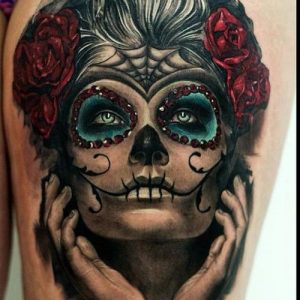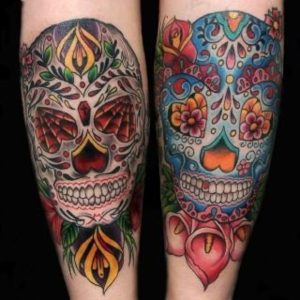Day of the Dead Tattoos
We are rounding off October and all the celebrations of the occult coming at us both through the boisterous festivities of Halloween, and the slightly more subdued tradition of All Souls’ Day. In Mexico, the greatest celebration is known as Dia de Los Muertos. The holiday goes one for two days, with the 1st of November known as Dia de Los Inocentes, or ‘Day of the Children’. The 2nd of November celebrates the lives of loved ones that have passed away with the ‘Day of the Dead’.
While Halloween focuses on all things spooky, terror and mischief, the Day of the Dead festivities are an explosion of life-affirming joy, with music, parades, and parties. Family and friends gather to celebrate the lives of loved ones who have passed away and to pray for them amidst colourful pageantry and ceremonies. As with all things and traditions with cool and iconic imagery, the holiday has inspired its own sub-genre of body art.
Lady of the Dead

Two symbols of the Day of the Dead, the sugar skull and the depiction of La Calavera Catrina have become particularly popular. The latter has become globally recognised, much because of the tattoos, and Halloween party-goers everywhere now paint their faces to resemble the characteristic lady skeleton. This means dark, sunken eye-sockets, the nose replaced by a black triangle, and sharp cheekbones to create the resemblance of a skull. What’s more, the lips will be sutured closed with (painted) stitches. The tattoos often depict beautiful young women with the same features and can be incredibly effectful and striking with the right shading.
Sugar skulls
Another of the holiday’s most recognisable symbols, the colourful sugar skull, has also become a highly requested tattoo. They can sometimes be done as memorials, often with the name of the person to whom it is dedicated across the forehead of the skull. The candied skulls are ornate, colourful, and often decorated with swirling flowers and other elements. Often their eye-socket will be shaped like hearts and filled with vibrant, jewel-like shades.
The flowers most often depicted in Day of the Dead tattoos are cempasuchitl, a Mexican marigold. They are usually strewn across memorial sites and altars during the holiday, as it is believed their vibrant colours attract the spirits to them. There can also be other elements to the tattoo, just as on the altars there are representations of earth, water, air and fire.
Celebrate life, respectfully

As with anything that comes from the traditions of another culture than your own, it is important to educate yourself on its symbolic meanings and to make sure you do not get it just because it is trendy or looks cool. What is known as cultural appropriation can dilute the significance of symbols and customs where they have initially been practised.
That being said, with the proper understanding and reverence, tattoos drawing inspiration from the Dia de Los Muertos are perhaps more potent now than ever, serving as reminders of the fragile borders between life and death, and how we should never take any moment we are given with our loved ones for granted. And to make life a celebration, as often as we can. Particularly with some new body art.
